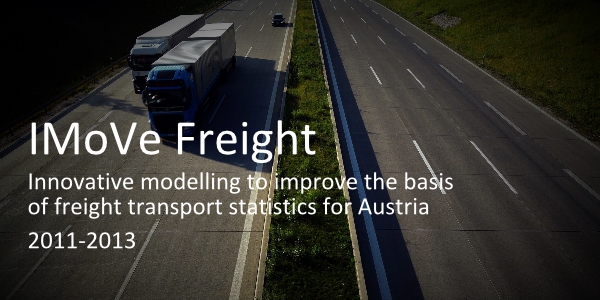IMoVe Freight

Important traffic planning decisions in Austria and the European Union require good and valid databases on freight transport. Due to the different data-collection sources and procedures, this data is not complete and not entirely compatible. It shows a tendency to underestimate road freight transport. The aim of this project is to deliver a concept for a valid, methodologically clearly conceived, ongoing and automated overall process of data consolidation and provision for freight transport as well as a prototype implementation to demonstrate feasibility.
Client: bmvit, I2V, 4th call for tenders
Duration: June 2011 to July 2013 (26 months)
Project partners: University of Natural Resources and Applied Life Sciences Vienna, WU-Vienna – Institute for Transport Economics and Logistics, Paradigma Unternehmensberatung GmbH
Project description:
Important planning decisions in Austria and the European Union require good and valid databases for freight transport. This applies both to planning decisions in the infrastructure sector and to organisational and financial policy measures, all of which have a great significance for Austria’s economic location and for Austria’s objective of sustainable development. The aim of this project is to deliver a concept for a methodological, ongoing and automated process of data provision for freight transport in Austria that is upstream of these planning decisions. The focus of the contract is freight transport by road. In other modes of transport (rail, inland waterway transport), the volume generated by intermodal transport using the road is of interest, especially in the pre-carriage and onward carriage of large containers (containers, swap bodies).
A number of data sources are available for determining the volume of freight traffic and the corresponding transport performance. These sources include the official freight transport statistics of Austria, the European traffic statistics of the Statistical Service of the European Commission as well as supplementary national surveys, in particular the survey on transalpine freight traffic (CAFT), the data of the electronic toll on Austrian motorways and expressways and cross-sectional surveys on the high-ranking road network and the roads in the administration of the federal states. The different survey contents and methods of these data sources result in a number of inhomogeneities that cannot easily be evaluated together. These are structured in terms of space, time and content and range from under-recording in official road transport statistics to incompatibilities in European statistics (differences in member states’ surveys, to incompatibilities with Asfinag’s electronic-toll data for truck traffic). Based on a comprehensive analysis of the available data sources, the quality of the data is checked and processed within the process to be designed.
In accordance with the existing inhomogeneities, these are harmonised with each other (e.g. using a method based on the principle of entropy maximisation) and where this is not possible due to lack of information, supplemented in an appropriate manner by imputation techniques. Plausibility checks are carried out using endogenous data sources. After completion of the concept developed in the project to improve the basis of road-traffic statistics, it will be applied for a reference year for Austria.
Contact: Alex Schubert
